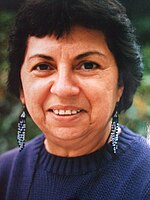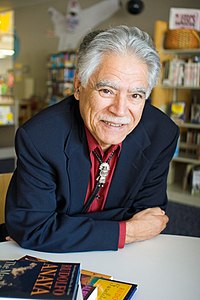Mexican-American literature
Although its origins can be traced back to the sixteenth century, the bulk of Mexican American literature dates from post-1848 and the United States annexation of large parts of Mexico in the wake of the Mexican–American War.
Some scholars argue that the origins of Mexican American literature can be traced back to the sixteenth century, starting with the chronicle written by Spanish adventurer Álvar Núñez Cabeza de Vaca, who published an account in 1542 of his long journey in what is now the U.S. Southwest, where he lived with various indigenous groups, learning their language and customs.
[9] By 1900, according to critic Raymund Paredes, "Mexican American literature had emerged as a distinctive part of the literary culture of the United States.
"[10] Many different genres of Mexican American literature, including narrative, poetry, and drama, now have a wide popular and critical presence.
Composed mostly of Spanish-speaking Catholics living in a predominantly English-speaking Protestant country, Mexican Americans have had the status of a linguistic and cultural minority.
There are also people who do not fit easily in these definitions, such as Josefina Niggli, whose parents were Anglo Americans living in Mexico when she was born.
[15] After the U.S.-Mexican war, Mexicans saw themselves as being denied their civil rights while having U.S. citizenship; they found themselves receiving much lower pay than White labor who disregarded their skill level.
[19] People born in the U.S. to immigrant parents face an assimilation process where they try to adapt to their communities, but still feel like they're considered foreign.
[20] Major or notable figures in Mexican American literature include: María Ruiz de Burton, Adela Sloss Vento, Sabine R. Ulibarri, Jovita González, Maria Cristina Mena, Francisco Jiménez, Américo Paredes, Adina Emilia de Zavala, Ron Arias, Rafael C. Castillo, Gary Soto, John Rechy, Denise Chavez, Daniel Olivas, Pat Mora, Benjamin Alire Sáenz, Victor Villaseñor, Tomás Rivera, Luis Alberto Urrea, Sergio Troncoso, Rolando Hinojosa-Smith, Kathleen Alcalá, Rudy Ruiz, Jimmy Santiago Baca, Lucha Corpi, and Leroy Quintana.
Many Mexican Americans and Chicanos celebrate their cultural roots, including historical practices such as the Day of the Dead.
During El Movimiento, in which Chicanos were fighting for social and civil rights in the United States, several Chicana writers began to write, forming an important part of the movement.
Her focus primarily dealt with sexual and cultural oppression, while Moraga made significant contributions to addressing queer and lesbian identities among Chicano/a people.
In 2003, author Alisa Valdes-Rodriguez published The Dirty Girls Social Club, a chick lit novel aimed at Latina women.
[30] Michele Serros was a Latina writer drawing on her own life experiences, much of her works gave voice to the complexities of lives straddling two worlds: working-class Mexican-American heritage and southern California pop culture.








